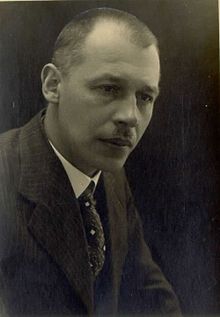Srečko Brodar (May 6, 1893 – April 27, 1987) was a Slovene archaeologist, internationally best known for excavation of Potok Cave (Slovene: Potočka zijalka), an Upper Palaeolithic cave site in northern Slovenia.
Srečko Brodar | |
|---|---|
 Srečko Brodar in the 1930s | |
| Born | Felix Brodar May 29, 1920 |
| Died | April 27, 1987 (aged 93) |
| Nationality | Slovene |
| Occupation | Archaeologist |

Life edit
Broidar was born in Ljubljana, the illegitimate son of Franciska Brodar, and baptized Felix Brodar[2] (Srečko is a Slovenized equivalent of Felix).[3] Brodar studied at the University of Vienna and University of Zagreb, graduating in 1920. Beginning in 1921, he taught at Celje Grammar School, and after the First World War, during which he received a serious elbow injury, he in 1939 received his PhD from the University of Ljubljana, and became a professor there in 1946, serving as the chair of Archaeological Department until retirement. Brodar was the director of the Institute of Archaeology at the Slovenian Academy of Sciences and Arts, and a member of the International Union for Prehistoric and Protohistoric Sciences.[4] His son Mitja Brodar (1921–2012) was also a noted archaeologist.
Work edit
In 1928, he became famous with the excavation of Potok Cave (Slovene: Potočka zijalka) and five other Palaeolithic sites in Slovenia, demonstrating the link between the Palaeolithic cultures of the eastern Alps and those of the Pannonian Plain and northern Italy.
After World War II, Brodar's research focused on Betal Rock Shelter (Betalov spodmol), a multiperiod prehistoric site near Postojna in southwest Slovenia. He also discovered the first Mesolithic sites in Slovenia, such as Špehovka Cave.[4]
Awards edit
- 1949 Prešeren Award for excavations at Betal Rock Shelter.[5]
- 1960 Prešeren Award for excavations at Črni Kal
- 1974 Kidrič Award
References edit
- ^ Debeljak, Irena; Turk, Matija. "Potočka zijalka". In Šmid Hribar, Mateja; Torkar, Gregor; Golež, Mateja; et al. (eds.). Enciklopedija naravne in kulturne dediščine na Slovenskem – DEDI (in Slovenian). Retrieved 12 March 2012.
- ^ Geburts- und Tauf-Buch. Ljubljana – Sv. Peter. 1884–1893. p. 331. Retrieved January 3, 2024.
{{cite book}}: CS1 maint: location missing publisher (link) - ^ Keber, Janez (1988). Leksikon imen. Celje: Mohorjeva družba. p. 176.
- ^ a b Josipovic, Drasko (2001). "Brodar, Srecko". In Tim Murray (ed.). Encyclopedia of Archaeology: History and Discoveries. Santa Barbara, CA: ABC-CLIO. Retrieved 8 November 2010.
- ^ Prešernov Sklad [Prešeren Fund] (2009). "Prešernove nagrade" [Prešeren Awards] (PDF) (in Slovenian). Archived from the original (PDF) on 17 July 2011. Retrieved 8 November 2010.
Further reading edit
- Likar, Peter (1996). Odkril sem Potočko Zijalko (a transcript of a 1970s documentary film about Srečko Brodar)
External links edit
- Media related to Srečko Brodar at Wikimedia Commons